冀教版-英语-七上-第13课Body Parts说课稿
- 格式:doc
- 大小:166.00 KB
- 文档页数:6
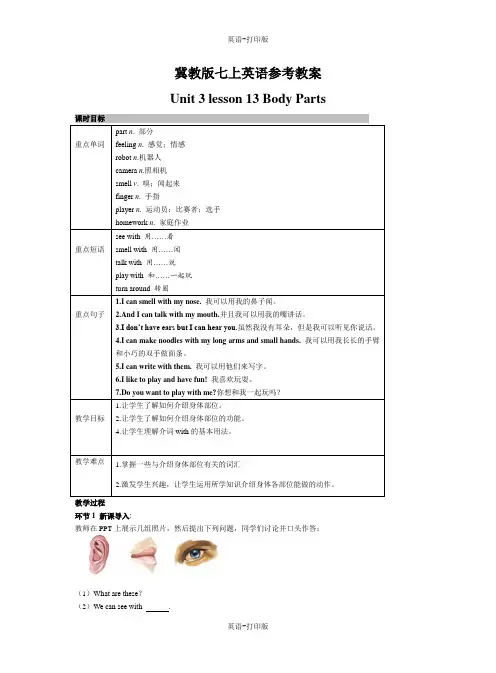
冀教版七上英语参考教案Unit 3 lesson 13 Body Parts 课时目标重点单词 part n . 部分 feeling n . 感觉;情感robot n .机器人camera n .照相机smell v . 嗅;闻起来finger n . 手指player n . 运动员;比赛者;选手homework n . 家庭作业重点短语 see with 用……看 smell with 用……闻talk with 用……说play with 和……一起玩turn around 转圈重点句子 1.I can smell with my nose. 我可以用我的鼻子闻。
2.And I can talk with my mouth.并且我可以用我的嘴讲话。
3.I don’t have ears but I can hear you.虽然我没有耳朵,但是我可以听见你说话。
4.I can make noodles with my long arms and small hands. 我可以用我长长的手臂和小巧的双手做面条。
5.I can write with them. 我可以用他们来写字。
6.I like to play and have fun! 我喜欢玩耍。
7.Do you want to play with me?你想和我一起玩吗?教学目标1.让学生了解如何介绍身体部位。
2.让学生了解如何介绍身体部位的功能。
4.让学生理解介词with 的基本用法。
教学难点 1.掌握一些与介绍身体部位有关的词汇2.激发学生兴趣,让学生运用所学知识介绍身体各部位能做的动作。
教学过程环节1 新课导入:教师在PPT 上展示几组照片,然后提出下列问题,同学们讨论并口头作答:(1)What are these ?(2)We can see with .(3)we can hear with .设计意图:通过图片展示更加直观地呈现本课时的主题:body parts。


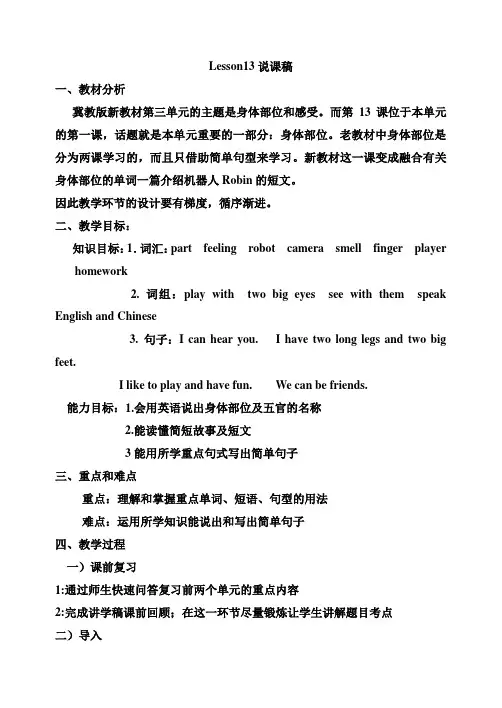
Lesson13说课稿一、教材分析冀教版新教材第三单元的主题是身体部位和感受。
而第13课位于本单元的第一课,话题就是本单元重要的一部分:身体部位。
老教材中身体部位是分为两课学习的,而且只借助简单句型来学习。
新教材这一课变成融合有关身体部位的单词一篇介绍机器人Robin的短文。
因此教学环节的设计要有梯度,循序渐进。
二、教学目标:知识目标:1.词汇:part feeling robot camera smell finger player homework2. 词组:play with two big eyes see with them speak English and Chinese3. 句子:I can hear you. I have two long legs and two big feet.I like to play and have fun. We can be friends.能力目标:1.会用英语说出身体部位及五官的名称2.能读懂简短故事及短文3能用所学重点句式写出简单句子三、重点和难点重点:理解和掌握重点单词、短语、句型的用法难点:运用所学知识能说出和写出简单句子四、教学过程一)课前复习1:通过师生快速问答复习前两个单元的重点内容2:完成讲学稿课前回顾;在这一环节尽量锻炼让学生讲解题目考点二)导入播放《head shoulders》这首英文歌导入本单元及本课话题:Body Parts。
引导学生回顾之前所学知识,努力说出小学所学过的有关身体部位的单词,并鼓励学生准确拼写出所说的单词。
板书所有学生说出的单词不全再做补充,并复习其复数形式。
三)引出新句型“I can … with (my)…”I can see with my eyes.I can hear with my ears.I can talk with my mouth.I can write with my hands.I can smell with my nose.…学生通过跟老师重复操练这一句型,并鼓励学生开拓思维,说出更多例句。
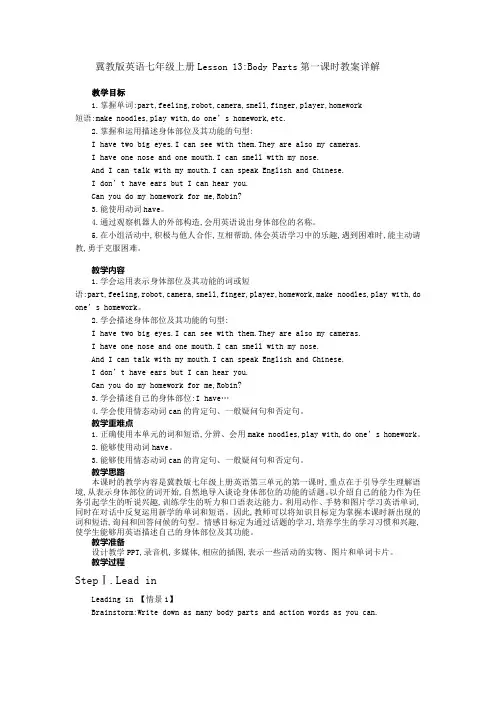
冀教版英语七年级上册Lesson 13:Body Parts第一课时教案详解教学目标1.掌握单词:part,feeling,robot,camera,smell,finger,player,homework短语:make noodles,play with,do one’s homework,etc.2.掌握和运用描述身体部位及其功能的句型:I have two big eyes.I can see with them.They are also my cameras.I have one nose and one mouth.I can smell with my nose.And I can talk with my mouth.I can speak English and Chinese.I don’t have ears but I can hear you.Can you do my homework for me,Robin?3.能使用动词have。
4.通过观察机器人的外部构造,会用英语说出身体部位的名称。
5.在小组活动中,积极与他人合作,互相帮助,体会英语学习中的乐趣,遇到困难时,能主动请教,勇于克服困难。
教学内容1.学会运用表示身体部位及其功能的词或短语:part,feeling,robot,camera,smell,finger,player,homework,make noodles,play with,do one’s homework。
2.学会描述身体部位及其功能的句型:I have two big eyes.I can see with them.They are also my cameras.I have one nose and one mouth.I can smell with my nose.And I can talk with my mouth.I can speak English and Chinese.I don’t have ears but I can hear you.Can you do my homework for me,Robin?3.学会描述自己的身体部位:I have…4.学会使用情态动词can的肯定句、一般疑问句和否定句。
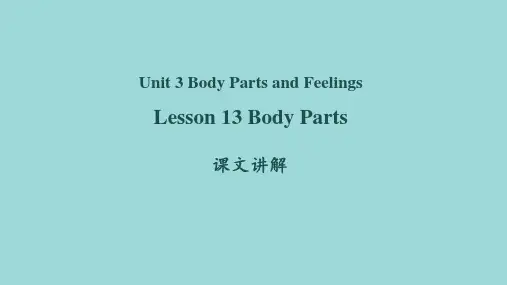
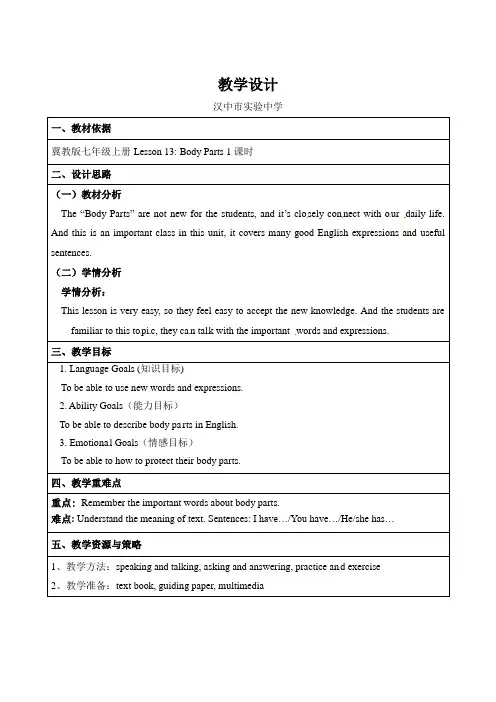
教学设计汉中市实验中学一、教材依据冀教版七年级上册Lesson 13: Body Parts 1课时二、设计思路(一)教材分析The “Body Parts” are not new for the students, and it’s clo sely con nect with o ur daily life. And this is an important class in this unit, it covers many good English expressions and useful sentences.(二)学情分析学情分析:This lesson is very easy, so they feel easy to accept the new knowledge. And the students are familiar to this topi c, they ca n talk with the important words and expressions.三、教学目标1. Language Goals (知识目标)To be able to use new words and expressions.2. Ability Goals(能力目标)To be able to describe body pa rts in English.3. Emotional Goals(情感目标)To be able to how to protect their body parts.四、教学重难点重点: Remember the important words about body parts.难点: Understand the meaning of text. Sentences: I have…/You have…/He/she has…五、教学资源与策略1、教学方法:speaking and talking, asking and answering, practice an d exercise2、教学准备:text book, guiding paper, multimedia五、教学过程教学环节教师活动学生活动设计意图Step 1 Lead-in Listen to an Engli sh song to leadto the new lesson.Sing the song and dosome actionsDraw students’attention.Step 2 Learning Objectives Show the learning objectives. Read aloud together. Make studentsknow what theywill learn in thislesson.Step 3 Listening 1. Give questions before listening.2. Listen to the tape together.Li sten and answer thequestions.Improve theirs kills of solvingproblems.Step 4 Reading 1. Give questions before reading.2. Read the text together andanswer the questions.Read and answer thequestions.Improve theirreading skills.Step 5 Exercise Let students introduce their bodyparts with phrases“I have…;He/shehas…”Introduce their bodyparts with the correctsentence patternsOutput partStep 6 Guessing Game 1. Show picture of a student, pointhis b ody parts and let th em guesswho is he.2. Finish the exercise 3 on Page37.Finish the guessinggame.Arousing theirinterests of bodypartsStep 7HomeworkFinish English Weekly of Lesson 13.六、板书设计。


2020学年冀教版英语精品资料Lesson 13 Body Parts1.整体设计思路、指导依据说明这节课主要是学习如何用简单的英语描述外貌特征,以及通过描述身体的各部位进而描述身体各部位的功能。
文章没有用真实的人物,而是用机器人Robot,增强了可读性,学生更容易接受,我在设计本课时,除了用图片及语篇引入新词外,还让学生描述动画片中的形象史莱克,激发他们的学习兴趣。
《新课标》指出:学生通过英语课程能开阔视野,认识世界的多样性。
应注重语言学习的过程,强调语言学习的实践性,主张学生在语境中接触、体验和理解真实语言,并在此基础上学习和运用语言。
鼓励学生在教师的指导下,通过体验、实践、参与、探究和合作等方式,发现语言规律,逐步掌握语言知识和技能,不断调整情感态度,形成有效的学习策略,发展自主学习能力。
同时对学生进行大量的语言输入,提供丰富的课程资源,创造性地开发和利用英语学习资源,拓展学生学习和运用英语的渠道。
2.教学背景分析教学内容分析:教材第二单元是颜色和衣物,本单元是身体部位和感受,可以用到上一个单元用到的颜色及衣物,更清楚准确地描述人物的外貌特征。
而本课主要是研究如何描述人体各部位名称及其功能。
学情分析:七年级的孩子学习英语的积极性很高,而且这篇课文不是很难,主要问题是如何通过多种活动调动学生的多种感官,慢慢形成他们的语篇意识。
3. 学习目标分析1. 通过观察机器人的外部构造,会用英语说出身体部位及五官的名称。
2. 通过介绍身体的部位,正确而灵活使用have/has,并能对自己和他人的相貌进行描述。
3. 在小组活动中,积极与他人合作,互相帮助,体会英语学习中的乐趣,遇到困难时,能主动请教,勇于克服困难。
4.教学重点、难点分析教学重点:part, feeling, robot, camera, smell, finger, player, homework, play with用简单的英语描述外貌特征。

Lesson13 Body Parts说课稿一、教材内容分析本课是冀教版七年级上册第三单元Body Parts and Feelings的Lesson13 Body Parts。
Body Parts 主要是学习如何用简单的英语描述外貌特征,以及通过描述身体的各部位进而描述身体各部位的功能。
文章没有用真实的人物,而是用机器人Robot,增强了可读性,学生更容易接受。
新课程标准和大纲倡导体验、实践、参与、合作与交流的学习方法和任务型的教学途径。
根据本课的特点,我将围绕本课重点,设计符合学生接受水平及特点的活动内容,并教给学生更多的时间与空间通过小组与个人学习的方式,让学生通过直观的体验与听、说、读、写等多种方式让学生的英语语言水平得到锻炼和提高。
二、教学目标新课程强调知识与技能、过程与方法、情感态度与价值观三个角度的有机结合,本着这样的认识,我制定如下教学目标。
通过观察机器人的外部构造,会用英语说出身体部位及五官的名称以及相应的动作。
Eye(s)—see;nose—smell;mouth—talk;ear(s)—hear;leg(s)—walk;finger(s)—play games;feet-play football.通过介绍身体的部位,正确而灵活使用I have...; I can ...with my...对自己的相貌进行描述,提高英语语言的综合运用能力。
通过活动、游戏使学生产生学习英语的兴趣;让学生敢于、乐于开口,积极参与交流。
并让学生在学习的过程中,培养他们的合作意识和竞争意识。
三、教学重难点教学重点:有关身体部位的单词及相应的动词。
教学难点:用I have .... I can do ... with my ...较为流畅地描述外貌特征。
四、学法自主学习探究学习合作学习五、教学过程设计StepI . Warming-up and leading-in1、Greetings (师生简单对话,相互问好,并介绍新朋友Robot)Robot: Hello!I am a robot. My name is Robin. Nice to meet you.Ss: Nice to meet you, too.Robot: Can you help me,my dear friends?I don’t know how to say the diff erent body parts in English?Can you help me to write them down?2、学生用英语标注机器人的不同身体部位,并写出更多有关身体部位的动词。
[设计思路:利用头脑风暴让学生以最短的时间写出关于身体部位和动作的词汇,利于后面的新知学习。
]3、老师展示实物,并做示范,引导学生以Robin的身份介绍身体不同部位。
Eg:This is my nose. I have one nose. I can smell with my nose.(it)These are my feet. I have two feet. I can play football with my feet.(them)StepII. Listening (听)1.Listen to the tape about the passage. Try to complete Let’s Do It!No.1(听录音,完成let’s Do It!No.1)2. Listen and check.3.PresentationStepIII. Reading.Read the passage and complete the following tasks:(1) Guessing game. Let’s Do It!No.3(2)任务型阅读1.Robin is good at basketball. (T or F)2.Robin can speak_______ and________3.Can Robin hear?___________4.What can Robin make noodles with?_____________________________5.Robin can help Danny_____A. put on his clothesB. make noodlesC. do his homeworkD. play basketballStepIV.Practice.(Group—work)1. Label Tina’s body parts. Describe his body parts.老师展示一个娃娃Tina。
要求学生以Tina的身份做自我介绍。
(学生先写,然后展示)(尽量用上之前列举出来的单词)(two black eyes,---read; mouth—enjoy delicious food/sing songs; ears—listen to music 2、Presentation,StepV. Extention1.Dig In1.An Eye for an eye and a tooth for a tooth.。
2. Tom likes to talk with others face to face.3. My father and I see eye to eye on the problem.。
4. Two heads are better than one .5.You are the apple of my eye.2.Let’s Do It!No.4.Listen and do the actions.StepVI. ConclusionStepVII. Homework:Read the text and write a pas sage named “My body parts”.Collect more words and expressions about body parts.六、Blackboard Design(板书设计)Lesson 13 Body Partsa nose.a mouthtwo eye s.I have two ear s. I can... with my...two leg s.two feet.七、教学反思本课的教学调动学生的多种感官,让学生动口、动手、动脑,使不同学习类型的学生都有所收获。
再通过头脑风暴、小组活动、猜谜游戏、歌曲等活动激发学生的学习兴趣。
通过拓展扩大学生的知识面。
但美中不足的是,学生在课堂中的训练还是不是很到位,尤其是在最后介绍身体部位时,可以留更多的时间给学生来在台前介绍自己的Body Parts,这样更能调动起学生,引导学生积极参与其中。
还有拓展部分在介绍有关身体部位谚语时,也是应该让学生先通过小组讨论,思考,让学生自己来完成,老师只需在学生需要的时候适当的指点就好,这样,才能更好地发挥学生学习的主体地位。
Write down as many words about body part and actions as they can. (写出关于身体部位、动作的词汇)[设计思路:利用头脑风暴让学生以最短的时间写出关于身体部位和动作的词汇,利于后面的新知学习。
]Step 3 Learn the new words.Show the students some pictures and sentences and help them grasp the new words.(设计意图:通过图片展示新词,突出重点、突破难点;通过语篇进行解释,使学生利用语境记单词和短语的含义。
)Step 4 Remember the new words as quickly as possible. Then fill in the blanks with the new words and expressions.Ask the students have a competition, see which student can remember the most new words.[设计思路:通过竞赛激发兴趣,通过展示音标帮学生正音。
通过趁热打铁及时练,掌握新词汇,为新授课打基础。
]Step 5 Listen and answer the questions:1. Who is Robin?2. Can Robin speak English and Chinese?3. What does Danny want Robin to do?Step 6 A Game: Read the text in group of four and try to ask more questions.,通过自己提问题,培养学生用英语做事情的能力。
设计思路:通过Step 8 Guessing gameFirst, describe a person, then let others guess who he/she is.Step 9 Listen to the song Hokey Pokey and do the actions.Put your right hand in.Take your right hand out.Put your right hand in,And shake it all about.Do the Hokey Pokey, And turn around. That’s what it’s all about.Step 10 Dig in1. Eye for eye and tooth for tooth.以牙还牙,以眼还眼。
2. He has a green thumb.他有特殊的园艺才能。
3. Tom likes to talk with others face to face.汤姆喜欢面对面地与别人交谈。
4. My father and I see eye to eye on the problem. 我和我爸爸在这个问题上看法一致。
Homework:Read the text and write a passage named “My body parts”.Collect more words and expressions about body parts.Read the passage “What is the most important part” and find good sentences.7.教学反思本课的教学调动学生的多种感官,让学生动口、动手、动脑,使不同学习类型的学生都有所收获。